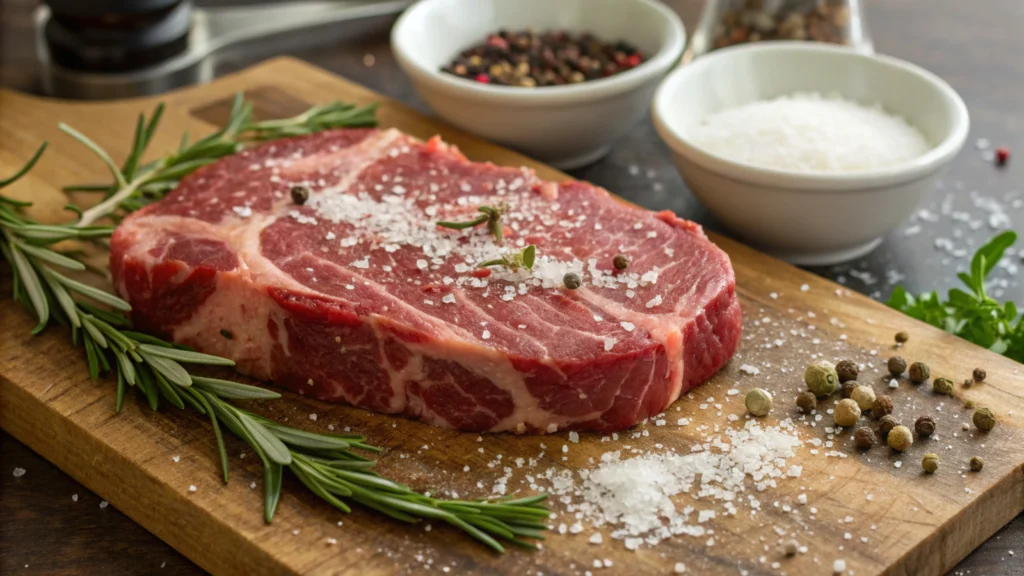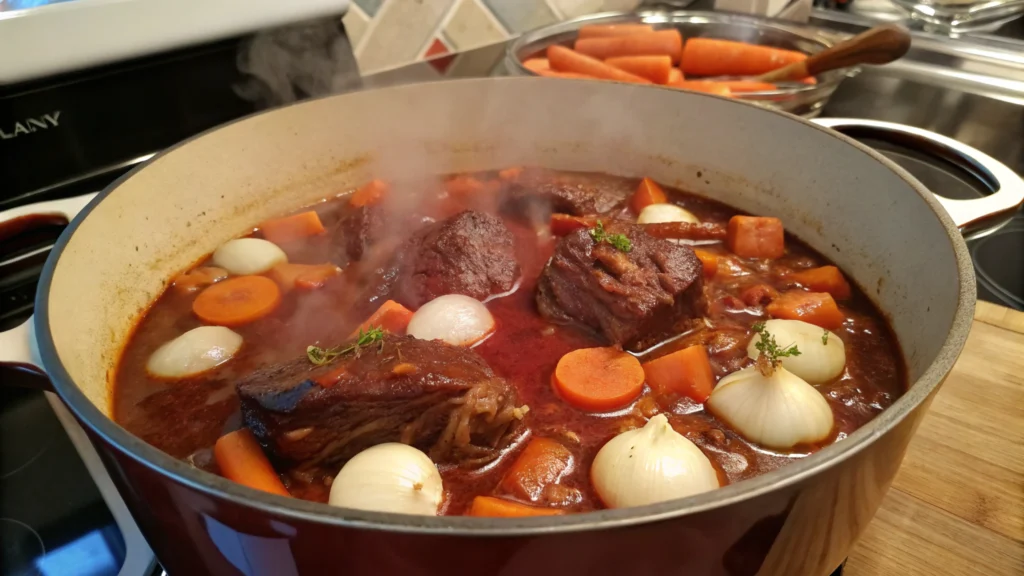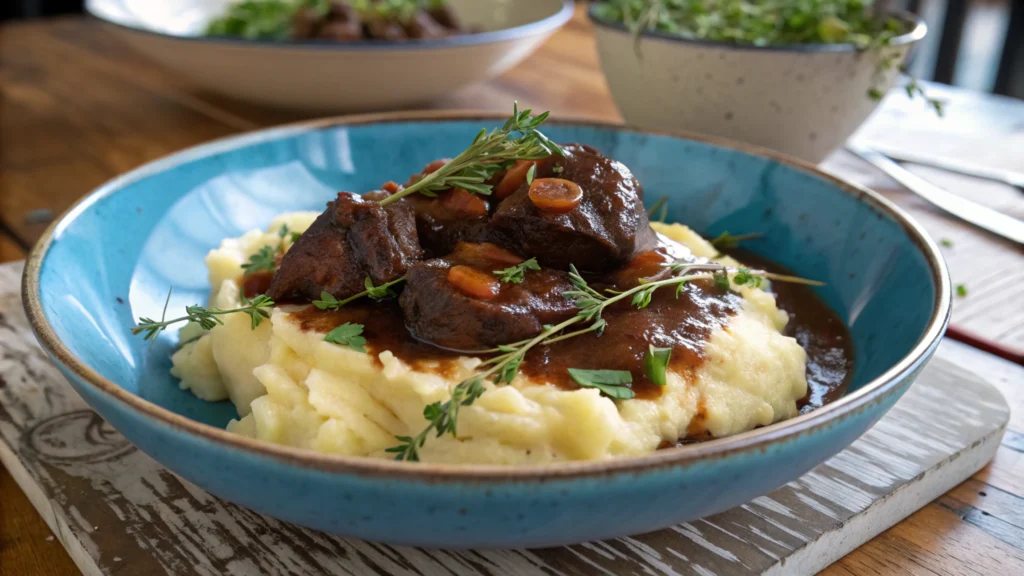Regarding underrated cuts of beef, pork cheek meat is a hidden gem. Known for its tender, melt-in-your-mouth texture whilst cooked right, this flavorful cut gives limitless possibilities inside the kitchen. From hearty stews to connoisseur tacos, pork cheek meat stands proud for its rich flavor and versatility. In this text, we’ll discover the entirety you want to know about red meat cheek meat: what it is, its nutritional advantages, cooking methods, and why it’s a favorite for home cooks and gourmet cooks alike.
Let’s discover why this unsung hero merits a niche in your next culinary adventure.
What is Beef Cheek Meat?
Understanding Beef Cheek Meat
Beef cheek meat, as the name shows, is the muscle group discovered in the cheek location of a cow. This reduces work during the animal’s existence, which gives it a dense, flavorful profile. It’s filled with collagen, a protein that, while slow-cooked, breaks down into gelatin, giving the beef a luscious texture perfect for hearty dishes. Unlike tenderloin or ribeye, red meat cheek calls for a chunk of patience. However, the payoff is worth every minute.
Historically, red meat cheeks have been a staple in conventional cuisines around the world, particularly in regions where no part of the animal goes to waste. Whether it’s Italian, Mexican, or French cuisine, beef cheek meat has usually been celebrated for its robust flavor and particular texture.
Nutritional Value
This cut isn’t just delicious—it’s also nutritious! Beef cheek meat is a high-protein, low-fat option compared to other beef cuts like ribeye or brisket. It’s particularly rich in iron, which supports healthy blood cells, and collagen, which is fantastic for joint and skin fitness. A serving of pork cheek can offer a wonderful supply of critical vitamins while preserving calories in the test.
When slow-cooked, the meat retains its nutrients, making it an excellent choice for healthy meals. Plus, it’s a tremendous alternative for those trying to balance flavorful consolation food with dietary value.
Why Choose Beef Cheek Meat?
If you’re wondering why beef cheek meat is well worth attempting, the solution lies in its versatility. This reduction works nicely in several dishes, from comforting stews to wealthy connoisseur recipes. Its ability to soak spices and seasonings makes it a favorite for cooks who love formidable flavors. What’s greater, beef cheek is an economical preference, offering top-class taste at a fragment of the price of more popular cuts.
In summary, red meat cheek meat is a powerhouse of taste, vitamins, and affordability. It’s the proper cut for adventurous chefs and comfort food fans alike.
How to Cook Beef Cheek Meat

Preparing Beef Cheek Meat
Before diving into the cooking system, putting together beef cheek meat nicely is vital. Start with the aid of trimming off any extra fat and sinew. While a small amount of fat adds taste, an excessive amount can create a greasy texture. Many recipes advocate marinating beef cheeks for numerous hours—or even overnight—to beautify their wealthy taste. Ingredients like crimson wine, vinegar, or citrus juice paintings are excellent for tenderizing the beef and adding depth to its flavor.
Pro tip: Pair your marinade with herbs like rosemary, thyme, and bay leaves to complement the beefy herbal flavor. Remember, the higher the coaching, the more gentle and flavorful the result.
Cooking Methods
So, what is red meat cheek meat precise for when it comes to cooking styles? The answer is nearly something slow-cooked or richly flavored! Here are some tried-and-authentic techniques:
- Braising is the gold standard for pork cheeks. Slow-cooking the beef in a liquid (assume broth, wine, or a tomato-primarily based sauce) transforms it into a soft-in-your-mouth satisfaction. The long cooking time permits the collagen to break down, resulting in a silky texture.
- Smoking: If you adore a smoky, pungent taste, smoking red meat cheeks is a super choice. The gradual heat and infusion of wooden chips create a wealthy, barbeque-style dish ideal for sandwiches or sliders.
- Pressure Cooking: Short on time? A strain cooker can tenderize beef cheeks in a fraction of the time, locking in all the scrumptious juices. This method is ideal for stews and curries.
Whatever technique you select, ensure a low and regular temperature to achieve the tender texture that makes red meat cheeks impossible to resist.
Pairing Ingredients for Beef Cheeks
Beef cheeks are adaptable and blend flavors beautifully, making them best for ambitious recipes. Combine them with root vegetables like carrots and parsnips for hearty stews, or serve them over creamy mashed potatoes for a comforting meal.
For inspiration, take a look at this guide to flavorful beef recipes for creative pairing ideas. Whether you choose conventional French dishes or spicy Mexican barbacoa, pork cheeks fit the bill.
Popular Dishes Made With Beef Cheek Meat

Global Dishes Featuring Beef Cheeks
From avenues and food to the best dining options, red meat cheeks are internationally favored. One standout is Mexican barbacoa, wherein the cheeks are gradually cooked with spices like cumin, chili, and garlic. Shredded pork cheeks make the ideal filling for tacos or burritos. Similarly, Italian delicacies celebrate beef cheeks in wealthy ragùs, served over pasta or polenta.
In French kitchens, pork cheeks are converted into dishes like daube de boeuf, a wine-braised stew providing tender chunks of meat and fragrant herbs. These dishes highlight how standard this cut indeed is.
Creative Applications in Modern Cuisine
In gourmet eating, cooks have embraced pork cheeks for their expensive texture. You’ll regularly find them paired with truffle-infused mashed potatoes or atop risottos. They’re also a remarkable addition to sliders, presenting a flavorful twist on a classic favorite.
For a smooth, at-domestic twist, attempt incorporating smoked pork cheeks into a barbecue sandwich or serve them shredded over nachos for a crowd-desirable appetizer.
Beef Cheek Recipes for Home Cooks
AA conventional beef cheek stew is the way to go if you’re searching for something easy yet pleasant. Toss the beef with onions, garlic, and your favorite vegetables, then braise it in purple wine or port. Want something with an Asian flair? Opt for a slow-cooked pork cheek curry with spices like turmeric, ginger, and cardamom.
This red meat recipe series explores even more delicious ways to use pork cheeks.
Benefits of Eating Beef Cheek Meat
Health Benefits of Beef Cheeks
When it comes to what red meat cheek meat top for, one standout motive is its dietary cost. Beef cheeks are rich in protein, making them an incredible choice for muscle restoration and electricity. They’re also loaded with iron, which plays a vital role in assisting wholesome blood cells and stopping fatigue.
One of the most particular benefits of red meat cheeks is their collagen content. Collagen, a protein found in connective tissue, breaks down during cooking to create a silky, gelatinous texture. This nutrient isn’t always just the least incredible for attaining tender but ever; it additionally supports joint fitness and skin elastic general well-being.
Since red meat cheeks are low in fat compared to other cuts, they’re an incredible choice for those seeking indulgent food without overloading on calories. Pair them with fresh veggies for a balanced, nutrient-packed dish.
Economic and Environmental Benefits
Beyond the fitness advantages, beef cheeks are budget-friendly. They’re often less expensive than high cuts like tenderloin or ribeye but offer much value. Foflavors cooks and chefs alike make them a clever choice for developing connoisseur meals on a budget.
From an environmental angle, the use of cuts like pork cheeks promotes sustainability. By utilizing more animals, we reduce meal waste and help create a more green meal system. If you want to eat consciously, pork cheeks are a delicious way to do it.
For more red meat recipes that use the whole animal, check out this manual on sustainable dishes.
Tips and Tricks for Perfect Beef Cheeks

Avoiding Common Cooking Mistakes
Cooking pork cheeks may appear intimidating, but with the right approach, it’s a breeze. One common mistake is undercooking the beef, which could leave it hard and chewy. Since beef cheeks are loaded with collagen, they must be simmered at low temperatures to acquire that melt-in-your-mouth texture.
Another tip? Don’t skimp on seasoning. Beef cheeks soak up flavors fantastically, so don’t be afraid to apply ambitious spices, marinades, or aromatic herbs. Whether braising in purple wine or smoking with a spicy rub, the flavor is prime to maximize the ability to reduce this.
Secrets to Perfect Texture
The mystery of flawlessly soft pork cheeks lies in low and gradual cooking. Braising is a traditional method that permits the beef to break down gradually, growing a silky texture almost impossible to replicate. Using a sluggish cooker or Dutch oven is ideal for this reason.
Try stress cooking to reduce the time without compromising on tenderness for a cutting-edge twist. Adding a hint of acidity, like wine or vinegar, enables further damage to connective tissue.
For more scrumptious ideas on how to prepare beef cheeks, see the recipes for slow-cooked beef dishes.
Beef Cheek Meat in Modern Food Trends
Popularity in Gourmet and Home Cooking
Beef cheek meat has become a favorite among chefs and home chefs alike. Its versatile taste profile and gentle texture make it a standout component for both conventional and revolutionary recipes. But what is red meat cheek meat excellent for in modern-day cooking? The answer lies in its capacity to elevate easy dishes into something awesome.
In connoisseur dining, beef cheeks frequently feature on high-end menus, paired with rich sauces and innovative sides. Think braised beef cheeks served atop truffle risotto or followed by a red wine discount. These dishes spotlight the cut’s capacity to hold ambitious flavors, making it a celeb element in any culinary setting.
At home, chefs are rediscovering beef cheeks as an inexpensive way to create restaurant-quality meals. From rustic stews to slow-cooked tacos, the opportunities are countless. And with the upward thrust of pressure cookers and slow cookers, attaining smooth, flavorful beef cheeks has never been simpler.
Cultural Resurgence of Traditional Cuts
As more people embrace sustainable eating, secondary cuts like beef cheeks are making a return. This cultural shift displays a deeper appreciation for the use of the whole animal—a practice celebrated in cuisines worldwide. In Italy, beef cheeks have long been a staple in comforting pasta dishes, while Mexican delicacies showcase their formidable flavor in dishes like barbacoa.
For food fans looking for an actual experience, these traditional recipes offer a significant connection to global culinary history.
FAQs
Why Do People Eat Beef Cheeks?
Beef cheeks are celebrated for their rich flavor and silky texture. When cooked efficiently, the beef turns soft, juicy, and infused with the dish’s flavors, making it ideal for consolation meals like stews and braises.
Do Beef Cheeks Taste Like Steak?
While pork cheeks lack the beefy taste of steak, their texture is wonderful. Unlike a steak, which is lean and firm, pork cheeks are extraordinarily smooth due to their collagen content, developing a soften-in-your-mouth experience.
Is Beef Cheek High in Collagen?
Yes! Beef cheeks are full of collagen, which breaks down during cooking to form gelatin. This not only enhances the texture but also provides fitness benefits for skin and joint health.
Is Beef Cheek Meat Tough?
Initially, beef cheeks are complex due to their dense connective tissue. However, with sluggish cooking or braising, the longevity melts away, leaving in the back of smooth, flavorful meat that’s a delight to eat.
The Role of Beef Cheeks in Sustainable Cooking
Embracing Nose-to-Tail Eating
In today’s culinary world, sustainability is more important than ever. One exceptional way to decrease waste and honor the entire animal is by working towards nose-to-tail consumption. So, what’s beef cheek meat good for in this movement? It’s a good example of how much less popular cuts can be transformed into connoisseur food, even by reducing meal waste.
Using cuts like red meat cheeks permits chefs to explore new flavors and textures, frequently at a lower cost than more conventional cuts. This not only supports more sustainable farming practices but also challenges cooks and home chefs to be more innovative in their kitchens.
Beef Cheeks and the Food Industry
The food enterprise is increasingly turning to secondary cuts like pork cheeks as purchasers call for more sustainable and inexpensive alternatives. Restaurants and meal delivery services are presenting dishes like braised red meat cheeks and tacos to promote this eco-conscious technique.
By embracing cuts like pork cheeks, we no longer only have fun with the culinary range but also contribute to a more accountable meals machine. For a more excellent proposal on sustainable cooking, try dishes that use the entire animal, like this pork-based recipe collection.
Pairing Beef Cheeks With Wine and Sides
The Best Wine Pairings for Beef Cheeks
Pairing the proper wine with pork cheeks enhances the flavor of the dish. Since pork cheeks are rich and hearty, they pair superbly with full-bodied pink wines. A sturdy Malbec or Shiraz complements the savory depth of slow-cooked or braised beef cheeks.
Opt for a Zinfandel or Grenache for recipes with spicy or smoky flavors, like barbacoa. These wines balance the warmth while enhancing the dish’s natural sweetness.
Perfect Sides to Complement Beef Cheeks
When planning a meal with red meat cheeks, the sides are just as essential as the main dish. Creamy mashed potatoes or cheesy polenta provide the proper base for soaking up the rich juices. For lighter options, roasted root greens or sautéed veggies add freshness and balance to the plate.
To deliver an international twist, serve pork cheeks with steamed rice and pickled vegetables for an Asian-inspired meal, or pair them with crusty bread for a country-European feel.
Adding these thoughtful pairings completes the dish and elevates the overall dining experience. Whether you are serving guests or enjoying a quiet dinner, the versatility of pork cheeks guarantees there is always room for creativity.


2 thoughts on “What Is Beef Cheek Meat Good For?”